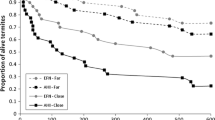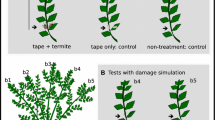Abstract
The question if ant behaviour and biological limitations should be considered before generalisations about the ant’s defensive capabilities in ant–plant relationships was explored through a new experimental manipulation. In the Brazilian tropical savanna, we tested the protective action of Cephalotes pusillus Klug on the extrafloral nectar-bearing plant Ouratea spectabilis Engl. (Ochnaceae). Three treatments were performed: control (free ant access), Cephalotes-treatment (access permitted only to C. pusillus), and ant free treatment (no ants). No difference was found in the levels of leaf herbivory among experimental stems. Visitation by different ant species to control stems translated into significantly greater fruit and seed production by this stem category than by ant-free and Cephalotes-treated stems. Thus, results showed that an investigation of system’s natural history, ant’s morphological traits, defensive capabilities and behaviour are needed before a protective role is inferred to each associated ant species.


Similar content being viewed by others
References
Bentley BL (1977) Extrafloral nectaries and protection by pugnacious bodyguards. Annu Rev Ecol Syst 8:407–427
Bronstein JL (1998) The contribution of ant plant protection studies to our understanding of mutualism. Biotropica 30:150–161
Bronstein JL, Alarcon R, Geber M (2006) The evolution of plants–insect mutualisms. New Phytol 172:412–428
Blüthgen N, Stork NE, Fiedler K (2004) Bottom-up control and co-occurrence in complex communities: honeydew and nectar determine a rainforest an mosaic. Oikos 06:344–358
Corn ML (1980) Polymorphism and polyethism in the neotropical ant Cephalotes atratus (L.). Insect Soc 27(1):29–42
Davidson DW, MCkey D (1993) The evolutionary ecology of symbiotic ant–plant relationships. J Hymenopt Res 2:13–83
Davidson DW, Cook SC, Snelling RR, Chua TH (2003) Explaining the abundance of ants in lowland tropical rainforest canopies. Science 300:969–972
Dejean A, Gibernau M, Durand JL (2000) Pioner plant protection against herbivory: impact of different ant species (Hymenoptera: Formicidae) on a proliferation of the variegated locust. Sociobiology 36:227–236
Del-Claro K (2004) Multitrophic relationships, conditional mutualisms, and the study of interaction biodiversity in tropical savannas. Neotrop Entomol 33:665–672
Del-Claro K, Marullo R, Mound LA (1997) New Brazilian species of Heterothrips (Insecta; Thysanoptera). Interacting with ants in Peixotoa tomentosa flowers (Malpighiaceae). J Nat Hist 31:1307–1312
Del-Claro K, Oliveira PS (1996) Honeydew flicking by treehoppers provides cues to potential tending ants. Anim Behav 51:1071–1075
Del-Claro K, Oliveira PS (1999) Ant-homoptera interactions in neotropical savanna: the honeydewproducing treehopper Guayaquila xiphias (Membracidae) and its associated ant fauna on Didymopanax vinosum (Araliaceae). Biotropica 31:135–144
Del-Claro K, Oliveira PS (2000) Conditional outcomes in a neotropical treehopper-ant association: temporal and species-specific effects. oecologia 124:156–165
Del-Claro K, Berto V, Réu W (1996) Herbivore deterrence by visiting ants increases fruit-set in an extrafloral nectary plant Qualea multiflora (Vochysiaceae) in cerrado vegetation. j trop ecol 12:887–892
Del-Claro K, Torezan-Silingardi H (2009) Insect-plant intractions: new pathways to a better comprehension of ecological communities in Neotropical savannas. neotrop entomol 38:159–164
Dirzo R, Dominguez CA (1995) Plant-herbivore interactions in Mesoamerican tropical dry forests. In: Bullock SH, Medina E, Mooney HA (eds) Seasonal tropical dry forests. Blackwell, Oxford, UK, pp 169–186
Fraser AM, Axe’n AH, Pierce NE (2001) Assessing the quality of different ant species as partners of a myrmecophilous butterfly. oecologia 129:452–460
Hölldobler B, Wilson EO (1990) The ants. Harvard Univ Press
Inouye DW, Taylor OR (1979) A temperate region plant–ant–seed predator system: consequences of extrafloral nectar secretion by Helianthella quinquenervis. ecology 60:1–7
Ito F, Higashi S (1991) Variance of ant effects on the different life forms of moth caterpillars. j anim ecol 60:327–334
Koptur S (2005) Nectar as fuel for plant protectors. In: Wäckers FL, van-Rijn PCJ, Bruin J (eds) Plant-provided food for carnivorous insects: a protective mutualism and its applications. Cambridge University Press, Cambridge, UK, pp 75–108
Korndörfer AP, Del-Claro K (2006) Ant defense versus induced defense in Lafoensia pacari (Lythraceae), a myrmecophilous tree of the Brazilian cerrado. biotropica 38(6):786–788
Miller TEX (2007) Does having multiple partners weaken the benefits of facultative mutualism? A test with cacti and cactus-tending ants. oikos 116:500–512
Mothershead K, Marquis RJ (2000) Fitness impacts of herbivory through indirect effects on plant–pollinator interactions in Oenothera macrocarpa. ecology 81:30–40
Mody K, Linsenmair KE (2004) Plant-attracted ants affect arthropod community structure but not necessarily herbivory. ecol entomol 29:217–225
Ness JH (2006) A mutualism’s indirect costs: the most aggressive plant bodyguards also deter pollinators. oikos 113:506–514
O’Dowd DJ, Catchpole EA (1983) Ants and extrafloral nectaries: no evidence for plant protection in Helichryum spp.–ant interactions. oecologia 59:191–200
Oliveira PS, Del-Claro K (2005) Multitrophic interactions in a Neotropical savanna: ant–hemipteran systems, associated insect herbivores, and a host plant. In: Burslem DFRP, Pinard, MA, Hartley SE (eds) Biotic interactions in the tropics. Cambridge University Press, Cambridge, pp. 414–438
Oliveira PS, Marquis RJ (2002) The Cerrados of Brazil. Ecology and natural history of a tropical Savanna. Columbia University Press, New York, USA
Polis GA, Sears ALW, Huxel GR, Strong DR, Maron J (2000) When is a trophic cascade a trophic cascade? trends ecol evol 15:473–475
Price PW, Diniz IR, Morais HC, Marques ESA (1995) The abundance of insect herbivore species in the tropics: high local richness of rare species. biotropica 27:468–478
Réu WF, Del-Claro K (2005) Natural history and biology of Chlamisus minax Lacordaire (Chrysomelidae: Chlamisinae). neotrop entomol 34:357–362
Rico-Gray V, Oliveira PS (2007) The ecology and evolution of ant-plant interactions. The University of Chicago Press, Chicago, USA
Rosumek FB, Silveira FAO, Neves FS, Barbosa NP, Diniz I, Oki Y, Pezzini F, Fernandes GW, Cornelissen T (2009) Ants on plants: a meta-analysis of the role of ants as plant biotic defenses. oecologia 160:537–549
Sendoya SF, Freitas AVL, Oliveira PS (2009) Egg-laying butterflies distinguish predaceous ants by sight. amer nat 174:134–140
Stanton ML (2003) Interacting guilds: moving beyond the pairwise perspective on mutualisms. Am Nat 162:10–23
Tillberg CV (2004) Friend or foe? A behavioral and stable isotopic investigation of an ant-plant symbiosis. oecologia 140:506–515
Acknowledgments
The authors thank V. Stefani, J.R. Trigo, N. Blüthgen, and one anonymous referee for valuable comments on the text. Our laboratory thanks Clube de Caça e Pesca Itororó de Uberlândia for permiting the use of its cerrado. J. Byk thanks Capes–Coordenação de Aperfeiçoamento de Pessoal de Nível Superior for financial support. K. Del-Claro thanks Conselho Nacional de Ciência e Tecnologia (CNPq) (research grant) and also Fundação de Amparo à Pesquisa de Minas Gerais (Fapemig) for financial support.
Author information
Authors and Affiliations
Corresponding author
Rights and permissions
About this article
Cite this article
Byk, J., Del-Claro, K. Nectar- and pollen-gathering Cephalotes ants provide no protection against herbivory: a new manipulative experiment to test ant protective capabilities. acta ethol 13, 33–38 (2010). https://doi.org/10.1007/s10211-010-0071-8
Received:
Revised:
Accepted:
Published:
Issue Date:
DOI: https://doi.org/10.1007/s10211-010-0071-8




